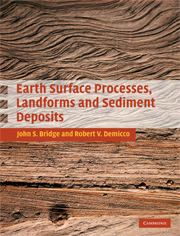Book contents
- Frontmatter
- Contents
- Acknowledgments
- Figure credits
- PART 1 Introduction
- PART 2 Production of sediment at the Earth's surface
- PART 3 Fundamentals of fluid flow, sediment transport, erosion, and deposition
- PART 4 Environments of erosion and deposition
- 13 Rivers, alluvial plains, and fans
- 14 Lakes
- 15 Coasts and shallow seas
- 16 Arid environments
- 17 Glacial and periglacial environments
- 18 Deep seas and oceans
- PART 5 Sediment into rock: diagenesis
- PART 6 Long-term, large-scale processes: mountains and sedimentary basins
- References
- Appendix: Methods of study of Earth surface processes, landforms, and sediments
- Index
- Plate section
17 - Glacial and periglacial environments
from PART 4 - Environments of erosion and deposition
Published online by Cambridge University Press: 05 June 2012
- Frontmatter
- Contents
- Acknowledgments
- Figure credits
- PART 1 Introduction
- PART 2 Production of sediment at the Earth's surface
- PART 3 Fundamentals of fluid flow, sediment transport, erosion, and deposition
- PART 4 Environments of erosion and deposition
- 13 Rivers, alluvial plains, and fans
- 14 Lakes
- 15 Coasts and shallow seas
- 16 Arid environments
- 17 Glacial and periglacial environments
- 18 Deep seas and oceans
- PART 5 Sediment into rock: diagenesis
- PART 6 Long-term, large-scale processes: mountains and sedimentary basins
- References
- Appendix: Methods of study of Earth surface processes, landforms, and sediments
- Index
- Plate section
Summary
Introduction
Approximately 10% of the Earth's surface is covered with ice at present. Most of this ice is in the Antarctic ice sheets (85% of ice by area), another major ice accumulation is on Greenland (12% of ice by area), and the remainder (3% by area) is in glaciers in mountainous regions. Conditions that allow permanent ice to exist (abundant precipitation as snow, and temperatures low enough to permit the snow to accumulate) occur at high latitudes, high altitudes, and near coasts. In addition to the areas of permanent ice, about 20% of the Earth's surface is permanently frozen (e.g., dry continental interiors at high latitudes such as Siberia, Canada, and Alaska).
In the past, large areas of the Earth's surface were covered in ice, and such ice ages have occurred at various times throughout Earth history (Figure 17.1). The last few millions of years of the Neogene ice age have been composed of cold periods (glacials) with intervening warmer periods (interglacials). During the Last Glacial Maximum (LGM) about 18,000 years ago, up to 30% of the Earth's surface was covered in ice, but the Earth is now in an interglacial period. The glacial–interglacial alternations of the past several million years, particularly the latest one, have left a remarkable record on the Earth's surface, and have affected human activities in many ways, perhaps even influencing our evolution.
- Type
- Chapter
- Information
- Earth Surface Processes, Landforms and Sediment Deposits , pp. 595 - 629Publisher: Cambridge University PressPrint publication year: 2008



